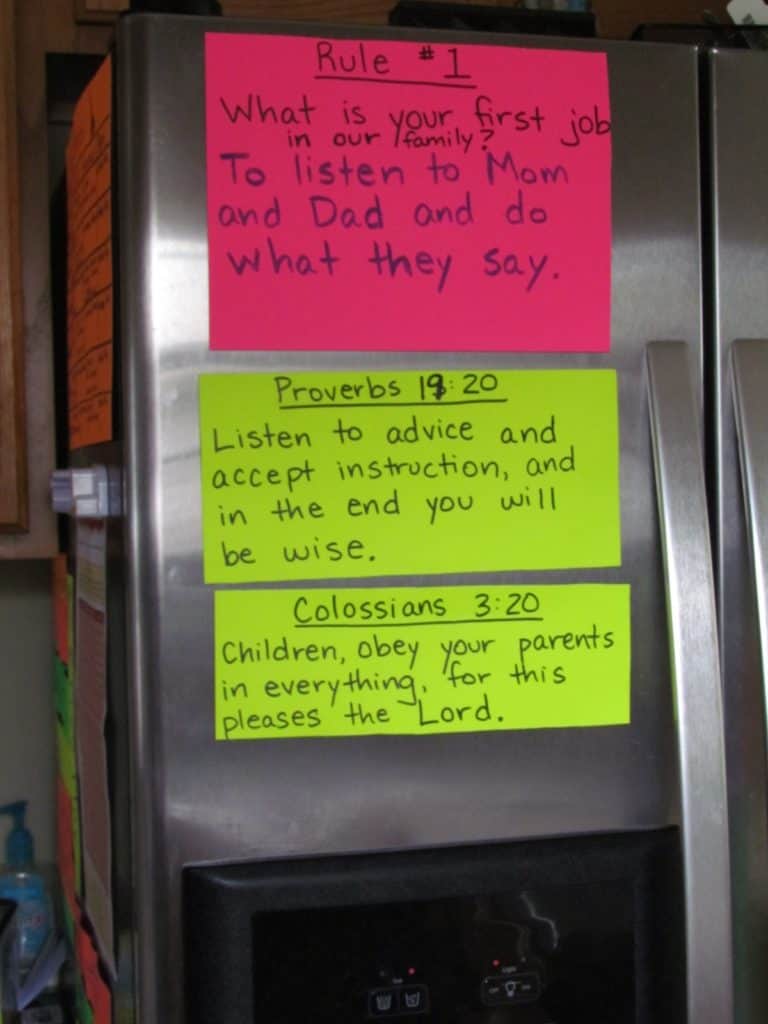Cultivating a Heart That Obeys: Strategies for Dealing with a Whiny, Insolent Child
Do you have a little one who is going through this phase of life where every…thing…is…sooooooo…hard–especially following directions from Mom and Dad? Here’s a fairly regular morning conversation right now around our house:
Mom: “Please go get your shirt on so we can go.”
4-Year-Old: (ignores parental directive)
Mom: (in slightly elevated voice) “Did you hear what I said? I need your help. Please obey mommy the first time.”
4-Year-Old: (emanates low grade whine and then collapses into a ragdoll heap on the floor)
Mom: If you don’t get your clothes on right now, we will have to leave without you.
 4-Year-Old: (looks slightly concerned but still doesn’t move and probably realizes that mom can’t follow through on that threat)
4-Year-Old: (looks slightly concerned but still doesn’t move and probably realizes that mom can’t follow through on that threat)
Mom: (parental realization that I can’t actually follow through with original threat and quickly shifting to new tactic) If you don’t go get your shirt on right now, I will pick it for you and you’ll have to wear whatever I pick out.
4-Year-Old: (in short, punctuated, ear-splitting intervals) No!….No!…NOOOOO!
Mom: (picks up 4-year-old and sets on her bed, while she is kicking and flailing) Sit on your bed…
4-Year-Old: NOOOO!!!
Mom: (headache forming; temperature rising; trying to remain calm) I said sit…
4-Year-Old: NOOOO!!!
Mom: (getting louder) When you have calmed down and are ready to get your shirt on…
4-Year-Old: NOOOO!!!
Mom: (almost yelling) …then, you may get down. (exit room)
4-Year-Old: (shouting down the hall) NOOOO!!!
The title of this post would suggest I have some definitive answers for you on the topic of parenting a whiny, insolent child. The truth is, yes, I’m gaining some wisdom in this terrain through experience with my first child, advice from friends, and reading The Bible and parenting books. But, my husband and I are in the thick of it right now with our 4-year-old (our second child) and still trying to see the light at the end of the tunnel. We feel like parenting failures at the end of many days at the moment. As with most of my parenting posts, I’m writing this as a reminder to myself…so I can keep in mind some important truths when I’m in the weeds.Here are four reminders during this season of child rearing for those of us dealing with a whiny, insolent child:
1 – Behavior begins in the heart, so we must deal with our child’s heart motivations first.
 The Bible says in Proverbs 4:23,"Keep thy heart with all diligence; for out of it are the issues of life." The “heart” is the central part of who you are, governing your will and emotions. So, all behavior comes from and is dictated by the motivations in our heart.
The Bible says in Proverbs 4:23,"Keep thy heart with all diligence; for out of it are the issues of life." The “heart” is the central part of who you are, governing your will and emotions. So, all behavior comes from and is dictated by the motivations in our heart.I read a well-intentioned blog post recently by a Christian mom who said she obliterated her child’s whining by filling a jar with a bean each hour she didn’t whine. Then, when the jar was full, she received a big prize. The mom did not discuss doing any teaching about why it’s wrong to whine or what God says about learning contentment and obedience, at least in this post. Although I have no doubt this rewards strategy did work in the short-run, I have to question what has now happened in that child’s heart. Will this little girl only cooperate when given external, short-term rewards? Is the parent now stuck in a pattern of having to keep tally of her child’s behavior daily and offering rewards to keep her motivated? Is the child learning self-control and the value of obedience as it relates to her relationship to God and in response to his promises…or just what it can gain her in the short term? And, what will this mean for how she relates to anyone in authority over her in the future, including God?
If we are simply trying to modify our child’s behavior without the long-term goal of changing their hearts, we are doing nothing more than cultivating little Pharisees in our home. Jesus had some very stern warnings for the Pharisees and their “good behavior” in Matthew 23:26-28. Thou blind Pharisee, cleanse first that which is within the cup and platter, that the outside of them may be clean also. Woe unto you, scribes and Pharisees, hypocrites! for ye are like unto whited sepulchres, which indeed appear beautiful outward, but are within full of dead men's bones, and of all uncleanness. Even so ye also outwardly appear righteous unto men, but within ye are full of hypocrisy and iniquity.
If we aren’t cultivating the ground of our children’s hearts and praying that God will change them by his Spirit, then we are missing the mark. We are only washing the outside of the cup but the inside is unclean. The outside may appear righteous, but the heart is still full of wickedness.
How can we reach a child’s heart instead of just changing behavior? A good place to start is by praying that God would change our child’s heart, like I was reminded of in a powerful way in the book A Praying Life by Paul Miller. In it he says,
It took me seventeen years to realize I couldn’t parent on my own. It was not a great spiritual insight, just a realistic observation. If I didn’t pray deliberately and reflectively for the members of my family by name every morning, they’d kill one another. I was incapable of getting inside their hearts…But even more, I couldn’t change my self-confident heart….As I began to pray regularly for the children, he began to work in their hearts…I did my best parenting by prayer. I began to speak less to the kids and more to God. It was actually quite relaxing. (p. 59)
Another good place to start to cultivate a heart of obedience is by simply asking these 3 questions when your child has done wrong, as a way to uncover heart motivation and give guidance. I’ll explain a few more practical ideas in point #4, as well.2 – Learning to obey is critical for children.
It’s paramount that my 4-year-old (and all of my kids) learn to obey Mom and Dad and those in authority right away and with a good attitude. The Bible makes great promises to those who learn to obey God and their parents.Proverbs 19:20: Hear counsel, and receive instruction, that thou mayest be wise in thy latter end.
Colossians 3:20: Children, obey your parents in all things: for this is well pleasing unto the Lord.
Ephesians 6:1-3 Children, obey your parents in the Lord: for this is right. Honour thy father and mother; which is the first commandment with promise;That it may be well with thee, and thou mayest live long on the earth.
In the incredibly helpful parenting book, Good and Angry: Exchanging Frustration for Character in You and Your Kids!
 God expects children to learn obedience at home, because hidden within that virtue are the principles that will make them successful as they get older. Teaching children to cooperate with you will also help them learn how to obey God and be responsible as they get older. (p. 9)
God expects children to learn obedience at home, because hidden within that virtue are the principles that will make them successful as they get older. Teaching children to cooperate with you will also help them learn how to obey God and be responsible as they get older. (p. 9)In our good moments (umm, that’s key), we remain calm and use our child’s temper tantrum or defiance as a teaching moment. We ask her, “What is your first job in our family?” The answer we have come up with and that she knows the answer to well now is, “To listen to Mom and Dad and do what they say.” When we take the time to discuss this together in the midst of defiance, she almost always responds the right way. This has reminded us that often our kids just need to be taught/reminded of their expectations first and then have consequences if they don’t respond. We also try to be proactive, not just reactive, by reminding the kids about once a week right now about this family rule and God’s promises to us.
So, point #2 in dealing with my whiny, insolent child, is the big picture: She must learn obedience. I don’t want to just give in or make excuses for my child’s behavior. I want to have the end goal in mind for her and deal with her wrong behavior consistently, because I know this is what is best for her in the long run.
3 – The manner in which I interact with my child can either bring healing or create distance between us.
My tone of voice and body language can either help diffuse her tantrums or rev them up. Michelle Anthony says in Spiritual Parenting, “The end goal for us as parents is to conduct God’s discipline in our children’s lives in such a way that they experience healing from their sin.” That’s what I want to do but have such a hard time remembering in the moment! God’s Word gives so much wisdom to this end. I often post these verses around my house, to help me fight my temptation to be impatient and get angry quickly.Psalm 103:8, The Lord is merciful and gracious, slow to anger, and plenteous in mercy.
Proverbs 14:29, “He that is slow to wrath is of great understanding: but he that is hasty of spirit exalteth folly
Proverbs 15:1,A soft answer turneth away wrath: but grievous words stir up anger.
James 1:19-20, “Wherefore, my beloved brethren, let every man be swift to hear, slow to speak, slow to wrath: For the wrath of man worketh not the righteousness of God.
In Good and Angry, Turansky and Miller say this about engaging in battle with our kids:
When a child begins mistreating a parent with arguing, meanness, or defiance, that child will feel many emotions, but especially guilt. People don’t like to feel guilty, and one of the easiest ways to excuse the guilt is to justify it by looking at the sins of others. When you join the boxing match, your children feel attacked and find it easier to blame you rather than focus on what they did wrong…As parents, we need to stay out of the boxing ring and allow the Holy Spirit to convict our children of sin. (p. 3)
They go on to explain that as parents we need to step out of “the boxing ring” and instead come around to our child’s “side of the ring” as a coach. When a fight begins, we must stop dealing with the issue at hand and instead discuss the way we’re relating. It means as a parent I need to choose “a different posture, one that offers healing instead of antagonism, and closeness instead of distance” (p. 4).4 – Set a routine that will teach my child how to accept instructions in life.
We all have routines of how we interact with our children in our home, some good and some bad. If you’re like me, I can easily get into a bad routine that doesn’t help my children respond the right way to my instructions. My anger, impatience, and short-sighted behavior-adaptation attempts at dealing with their behavior can make it worse in the end. Instead, I want to strive for a changed heart not just changed behavior in my child.In Good and Angry, the authors write:
It’s easy to feel angry because your children aren’t doing what you say. At those moments don’t respond with more harshness. Instead, move into a routine that teaches your kids how to accept instructions in life. This new pattern not only makes family life easier, but each step will train your children to respond to other leaders and eventually to God’s instruction. (p. 41)
Turkansky and Miller make these practical, heart-targeted suggestions for moving into a new and effective pattern of giving instructions and helping your child learn to obey. (I encourage you to read the entire book to address a whole host of behavioral issues you may be dealing with in your children and how to respond rightly.)Step 1: Get close together.
When you need to give an instruction, start by getting close to your child. Most of the time this means calling your child to come to you. At times, though, you may have to go to him. This takes lots of practice. But, what this teaches a child is that “dialogue only takes place when relationship has been established through eye contact and proximity….By affirming your relationship in the midst of the instruction, you teach your children an important lesson about the way God relates to us. Spirituality isn’t just a list of dos and don’t, but it comes within the sphere of relationship.” (p. 45)
Step 2: Consider the timing.
When getting ready to give instructions, we should consider “is it best to address this problem right now or would it be better to talk about it later?” “Pausing for just a moment, or in some cases, waiting a few hours, may prove to be the most productive way to deal with a problem.” (p. 47)
Step 3: Give the instruction.
Make a statement about your goals or objectives before you give the instruction. “Ben, I’m trying to get us to swim lessons on time. Can you please get your swim trunks out of your drawer and put them on?” This kind of statement gives your child more information, so they can feel like they are part of the team. The older the child, the more of an explanation is helpful.
Once you give the instruction, teach your child to respond to you. We often say to our younger kids, “Say, ‘okay mom’” after giving an instruction. A child’s answer reveals three things: 1) it shows that your child has heard you, 2) it teaches the child to communicate intent to follow through, and 3) you can hear what kind of attitude your child has.
Step 4: Wait.
Once you’ve given the instruction, ask your child to go do it and then report back to you. This gives them accountability to finish the task.
Step 5: The child checks back and you inspect and release him/her.
“After children report back and parents inspect what they’ve accomplished, everyone experiences a sense of completion.” This also gives you a chance to “praise your child for obeying, teach about responsibility, and foster a positive relationship…By getting the work checked, a child then experiences a sense of freedom. You give your children a gift by releasing them to go play or enjoy the rest of the evening.” (p. 55)

No comments:
Post a Comment